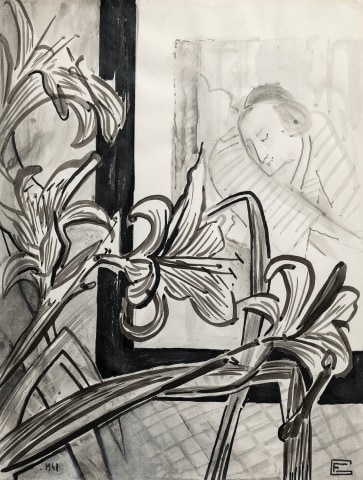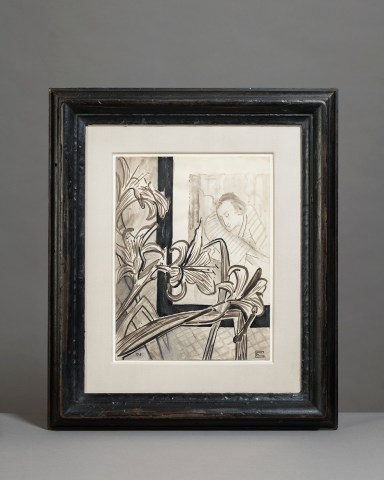Françoise Gilot
111. Still life with lilies and an Ukiyo-e print (A View), 1941
Brush with black ink and grey wash on paper
Signed with initials 'FG' (lower right); and dated '41' (lower left)
Signed with initials 'FG' (lower right); and dated '41' (lower left)
31.8 x 24.1 cm
11749
£ 28,000
Françoise Gilot's 1941 pen and black ink still life of lilies before a Japanese print offers valuable insight into her artistic evolution just prior to meeting Pablo Picasso in 1943....
Françoise Gilot's 1941 pen and black ink still life of lilies before a Japanese print offers valuable insight into her artistic evolution just prior to meeting Pablo Picasso in 1943. At this stage, she was still shaping her distinctive voice, yet this piece already demonstrates her command of composition, form, and line.
Often overshadowed by her relationship with Picasso, it is essential to recognise that her greatest influence and idol was, in fact, Henri Matisse. This piece showcases Matisse’s impact on Gilot's work, highlighting the bold and simplified forms that she admired. “Matisse was really my God,” Gilot would later say, adding that it was his “desire for finding the strongest and most simple way of expressing form and character” that she admired most.
Gilot first encountered Matisse's work while studying at the École des Beaux-Arts in Paris in the early 1940s. This exposure deeply resonated with her, as Matisse's innovative compositions inspired her artistic development. His approach to colour and form, rooted in the Japanese ukiyo-e woodblock prints that he admired, diverged from traditional Western perspectives, influencing Gilot's own exploration of flatness and expression.
Before the war, in 1936, Gilot often spent weekends at the country estate of family friend Jacques Beurdeley, a noted Post-Impressionist etcher. Beurdeley was significantly influenced by the likes of Puvis de Chavannes and James Whistler, and he studied under Fernand Cormon, who was known for his emphasis on strong draftsmanship. Beurdeley also learned alongside Eugène Carrière, renowned for his soft, atmospheric effects. Under Beurdeley’s mentorship, Gilot learned the essential and creative aspects of etching and dry point, wandering into the adjacent countryside with copper plates in hand to create etchings en plein-air. These diverse influences from Beurdeley’s training clearly passed on to Gilot, evident in her use of colour and form in the present work, as she skilfully blended technical skill with a love for the natural world.
In November 1940, just before her 19th birthday, Gilot participated in a spontaneous rally at the Arc de Triomphe to commemorate the armistice of 1918. This act of defiance against the German occupation plunged her into a reality marked by fear and uncertainty, as she was subsequently added to a list of hostages, requiring her to report daily to local authorities. Amid this tumultuous backdrop of danger and instability, she navigated her artistic practice, striving for expression and normalcy in a world turned upside down. By 1941, after her father successfully negotiated her removal from the hostage list, she established a studio in her parents' home and began designing ceramic buttons for Line Vautrin, channeling her creative energy into her work despite the oppressive environment.
This work therefore underscores her profound engagement with Matisse’s artistic legacy, predating her significant collaboration with Picasso. This dual influence shaped her trajectory as a vital artist in her own right, firmly establishing her identity in the rich tapestry of modern art.
The work comes from the collection of prominent collector, and friend and patron of the artist, Laura Pels (1931-2023), a distinguished philanthropist and patron of the arts, known for her significant contributions to the cultural and artistic communities.
Often overshadowed by her relationship with Picasso, it is essential to recognise that her greatest influence and idol was, in fact, Henri Matisse. This piece showcases Matisse’s impact on Gilot's work, highlighting the bold and simplified forms that she admired. “Matisse was really my God,” Gilot would later say, adding that it was his “desire for finding the strongest and most simple way of expressing form and character” that she admired most.
Gilot first encountered Matisse's work while studying at the École des Beaux-Arts in Paris in the early 1940s. This exposure deeply resonated with her, as Matisse's innovative compositions inspired her artistic development. His approach to colour and form, rooted in the Japanese ukiyo-e woodblock prints that he admired, diverged from traditional Western perspectives, influencing Gilot's own exploration of flatness and expression.
Before the war, in 1936, Gilot often spent weekends at the country estate of family friend Jacques Beurdeley, a noted Post-Impressionist etcher. Beurdeley was significantly influenced by the likes of Puvis de Chavannes and James Whistler, and he studied under Fernand Cormon, who was known for his emphasis on strong draftsmanship. Beurdeley also learned alongside Eugène Carrière, renowned for his soft, atmospheric effects. Under Beurdeley’s mentorship, Gilot learned the essential and creative aspects of etching and dry point, wandering into the adjacent countryside with copper plates in hand to create etchings en plein-air. These diverse influences from Beurdeley’s training clearly passed on to Gilot, evident in her use of colour and form in the present work, as she skilfully blended technical skill with a love for the natural world.
In November 1940, just before her 19th birthday, Gilot participated in a spontaneous rally at the Arc de Triomphe to commemorate the armistice of 1918. This act of defiance against the German occupation plunged her into a reality marked by fear and uncertainty, as she was subsequently added to a list of hostages, requiring her to report daily to local authorities. Amid this tumultuous backdrop of danger and instability, she navigated her artistic practice, striving for expression and normalcy in a world turned upside down. By 1941, after her father successfully negotiated her removal from the hostage list, she established a studio in her parents' home and began designing ceramic buttons for Line Vautrin, channeling her creative energy into her work despite the oppressive environment.
This work therefore underscores her profound engagement with Matisse’s artistic legacy, predating her significant collaboration with Picasso. This dual influence shaped her trajectory as a vital artist in her own right, firmly establishing her identity in the rich tapestry of modern art.
The work comes from the collection of prominent collector, and friend and patron of the artist, Laura Pels (1931-2023), a distinguished philanthropist and patron of the arts, known for her significant contributions to the cultural and artistic communities.



